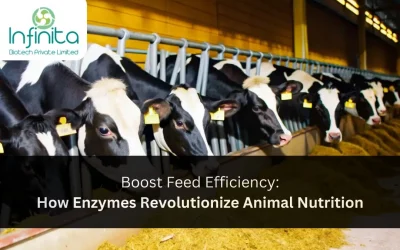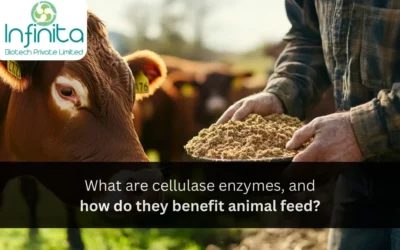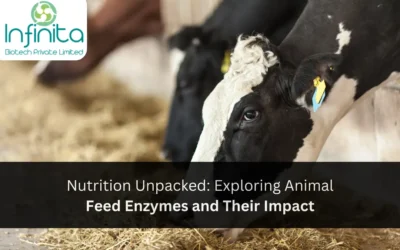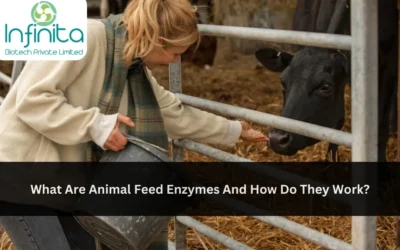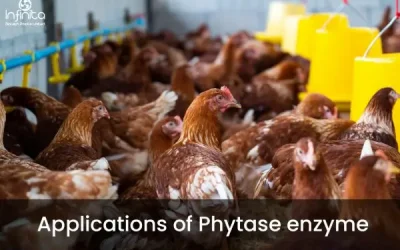The first enzymes developed by the biotech industry were the arabinoxylans and beta glucanases. Their function was to degrade non-starch polysaccharides, which are the fibrous portions of the grain. These enzymes reduced the viscosity of the non-digested grain in the intestine. The first trials proved that adding exogenous enzymes to wheat-based diets improved digestibility in monogastric animals. These early studies also helped scientists understand the mode of action of these enzymes and enabled them to develop new enzymes capable of working on a wider variety of substrates.
At the beginning of the 1990s, the main topic of conversation among nutritionists and researchers was what they considered to be the inevitable decline of sources of phosphorus in animal feed. The additives and supplements industry responded quickly to this challenge by focusing on enzymes capable of releasing more phosphorous through a molecule usually not present in livestock animals: phytate. Fungal phytase was able to chemically break down the phytate, releasing additional phosphorus in feed for pigs and poultry. While the nutritional matrixes of phytase would not be consolidated until 2000, they showed promising initial values of 0.05 phosphorus and a maximum of 0.10 percent available phosphorus.
When feed enzymes were first used more than a decade ago, their acceptance was limited to phytase applications for reduced phosphorus excretion. Although feed enzymes have been utilised for many years, we have only scratched the surface as research on feed enzyme technology.
The greater understanding of feed enzyme use comes at an ideal time as the demand for high-quality protein across the Globe continues to rise. With advancements in management and technology, animals are in production for a relatively short time. Producers need to maximise that time efficiently in order to meet increased protein requirements, including getting the most out of the feed.
Producers need to get smarter about optimising animal production in a sustainable manner — and enzymes offer an opportunity to do that.
Animal feed is the largest cost item in livestock and poultry production, accounting for 60-70% of total expenses. To save on costs, many producers supplement feed with enzyme additives, which enable them to produce more meat per animal or to produce the same amount of meat cheaper and faster.
Found in all living cells, enzymes catalyse chemical processes that convert nutrients into energy and new tissue. They do this by binding to substrates in the feed and breaking them down into smaller compounds. Enzymes can be classified by the types of substrates they work on. For instance: proteases break down proteins into amino acids, carbohydrases split carbohydrates into simple sugars, and lipases take apart lipids into fatty acids and glycerol.
Commercially-available enzymes can be derived from plants and animals (e.g., actinidin from kiwi and rennet from calf stomachs) as well as microorganisms (e.g., amylase from Bacillus and lactase from Aspergillus).
Enzymes and their modes of action:
1. Phytase
The substrate for phytase is phytic acid, which is how phosphorus is stored in plant tissues. Phytic acid is problematic to the animal because it binds minerals and amino acids which become unavailable to the animal. This results in beneficial nutrients being excreted into the environment, resulting in a loss in performance.
Phytase enzymes have been added to monogastric diets for more than a decade. As previously stated, the primary goal and mode of action of phytase are to reduce phosphorus excretion, and its use continues to increase due to diet cost savings. The initial savings are associated with reduced dietary phosphorus cost, but nutritionists also have the flexibility to reduce the amount of soybean meal due to improved amino acid digestibility.
2. Carbohydrase
The carbohydrase class of enzymes includes xylanases, glucanases, and amylases. They act in the stomach to break down and degrade carbohydrates such as fibre, starch, and non-starch polysaccharides into simple sugars that provide energy for use by the animal.
Grain sources such as corn, barley, and wheat have hard coatings on the outside. Much of the coating is physically broken up during feed mill processing, but not completely. The fibrous portion of grain cell walls is indigestible, and 10 to 20 percent is getting through. Carbohydrases will attack and degrade these starchy grain molecules.
One of the most common carbohydrates is xylanase. Xylanase attacks the arabinoxylan structure of corn or wheat, allowing the animal to absorb its components as an energy source. This limits the requirement for supplemental fat or energy in the final diet.
3. Protease
Protease enzymes are the newest technology on the block, with animal or vegetable protein as their substrate. They break down anti-nutritional factors associated with various proteins. Proteases improve the digestion of proteins and increase amino acid availability, which helps release valuable nutrients. The result is improved animal growth and performance and minimal negative effects of undigested protein in the hindgut.
Raw ingredients with low amino acid digestibility respond greatest to an exogenous protease, which is why its greatest value is when alternative ingredients are used in the diet. Proteases help producers manage the nutritional risks associated with feedstuff quality and allow them to best utilise all available feed ingredients.
Proteases are not limited to diets with alternative ingredients. Animals consuming a traditional corn-soybean meal diet cannot utilise 100 percent of the protein fraction. Therefore, adding a protease enzyme to a corn-soybean meal diet will enhance amino acid digestibility and animal performance.
Benefits Of Enzymes In Animal Feed
Even though there are still some segments of the pig and poultry industries that do not use exogenous enzymes, the growth of the enzyme market has been substantial. Since enzymes improve the digestibility of plant-based feed ingredients, they offer immediate economic benefits to animal production. Enzymes have allowed producers to further improve their feed conversion rates, the uniformity of their flocks and herds, and the efficiency of their feed mills since fewer grains are needed to be purchased and processed.
With all these benefits available to producers, the animal nutrition industry is becoming more eager to study enzyme technology in greater depth with the aim of further optimising animal production. Research is ongoing on the effects of degradation of different substrates, different methods of producing enzymes, epigenetic effects of enzymes in the formation and development of the intestine, and interaction with the microbiota and intestinal health, as well as their direct or indirect action on the immune system. As our understanding of enzymes evolves, we should expect a revolution in how we feed our animals.
Future Use Of Enzymes In Animal Feed
The benefits of enzymes are becoming better realised as more research is done. For the animal, enzymes optimise gut health, produce uniform growth and enhance overall health. For the producer, they decrease feed costs and improve profitability.
Each type of enzyme has its own specific function and therefore do not interfere with one another.
The bottom line is: the use of enzymes will continue to grow as we learn more about each technology.

